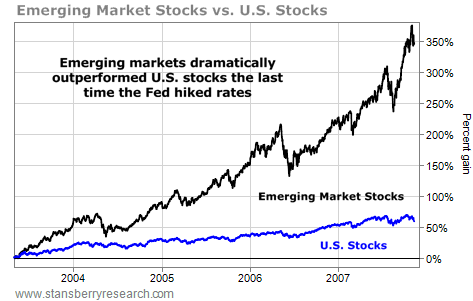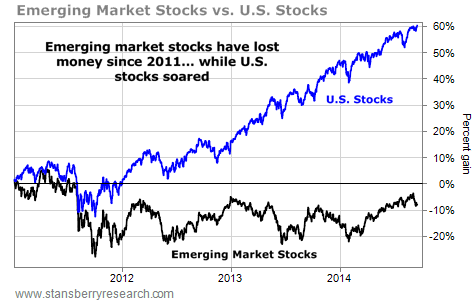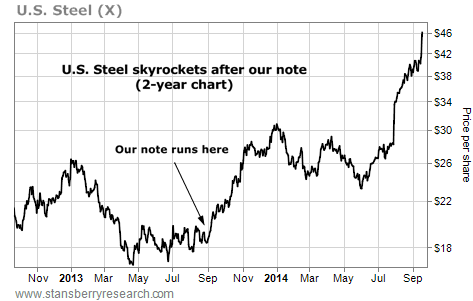| Home | About Us | Resources | Archive | Free Reports | Market Window |
400% Gains When the Fed Hikes RatesBy
Friday, September 19, 2014
The last time the Fed hiked interest rates, the investment I'll share with you today soared nearly 400%.
Most people think that you can't make money once the Fed starts raising interest rates.
They're wrong...
The last time the Fed hiked rates was from 2004 to 2006... Interest rates went up from 1.00% to 5.25%.
While most people thought higher rates would kill U.S. stock prices, the opposite happened, as I explained in this DailyWealth.
In short, the U.S. stock market soared from below 1,000 in 2003 to more than 1,500 in 2007 – a move of more than 50%.
Of course, stocks eventually crashed as the Global Financial Crisis hit in 2008. But importantly, stocks did NOT crash when the Fed started raising rates. The crash happened years later. From 2003 to 2007, smart U.S.-stock investors stayed in stocks when the Fed was raising interest rates, and they reaped big rewards.
However, the biggest gains didn't come here in the U.S...
They came overseas. More specifically, they came from emerging-market stocks.
Most investors aren't aware of it, but emerging-market stocks dramatically outperformed U.S. stocks from 2003 to 2007 – a period that included the rising interest rates of 2004 to 2006 – rising by nearly 400% percent:
 The same thing could happen again, starting now... To copy the 2003-2007 trade, you would want to buy emerging markets one year before the Fed raises rates, and hold for one year after they're done.
That means it's time to put this trade on now – as the Fed will raise interest rates next year.
You haven't missed out on it yet, though...
The U.S. has soared over the past few years – more than tripling from the financial-crisis bottom. But emerging markets have gone nowhere. They've lagged behind the U.S. so far. The chart below tells the story...
 U.S. stocks are up over 50% since 2011. But emerging markets still sit below 2011 levels. The gap is closing... After bottoming in February, emerging markets have finally joined in the global stock market boom.
Shares of the major emerging-markets fund, the iShares MSCI Emerging Markets Fund (EEM), are up 19% since their February bottom. And EEM reached a three-year high earlier this month.
It is time to place this trade...
The Fed has achieved its goals. Unemployment is down and inflation is rising. So the Federal Reserve will raise interest rates next year.
We can't know exactly when rates will rise. But we can be almost sure it'll happen sometime next year.
If history repeats (2003-2007), then the time to prepare your portfolios is now.
Consider buying emerging markets today. The simplest way is through EEM.
For much more specific emerging-market ideas that have even more upside potential, please see the latest issues of my True Wealth and True Wealth Systems newsletters.
I am optimistic on emerging markets right now... Don't miss out on this opportunity...
Good investing,
Steve
Further Reading:
While Steve says U.S. interest rates will rise next year, Europe has just cut interest rates to below zero. "I said this was likely to happen," Steve writes. "And I told you what you should do about it." Get all the details here.
If you still can't stand the thought of owning European stocks, Dr. David Eifrig has another super-safe way to diversify... "For folks worried about diversifying their assets out of U.S. dollars, this is one of the greatest ideas in the world..." Get the details here.
Market NotesA 'BAD TO LESS BAD' TRADE WORTH 150% Our "steel call" from last year has produced incredible gains...
Late last year, we told you to consider steel stocks. Despite all the great technological gadgets we enjoy, the world is still built on a foundation of steel, concrete, and other vital materials. Bridges, factories, buildings, trains, cars, and appliances, all require steel.
The steelmaking industry is a major "boom and bust" sector. It experiences big upswings... and then big downswings. Get into the booms early, avoid the busts, and you can make great money trading steel.
From early 2011 to mid-2013, steel was in "bust mode." A weak global economy and excess production caused huge losses in steel stocks. Steel giant U.S. Steel (X) fell from $60 per share to $17 per share. After the drop, we said, "If things simply get a little 'less bad' for the sector, U.S. Steel and its competitors could easily jump 50%."
As you can see in the chart below, things have gotten "less bad" for the steel industry. However, our upside estimate was low. U.S. Steel has skyrocketed 150% since our note. It's a heck of a "bad to less bad" winner.
 |
Recent Articles
|



